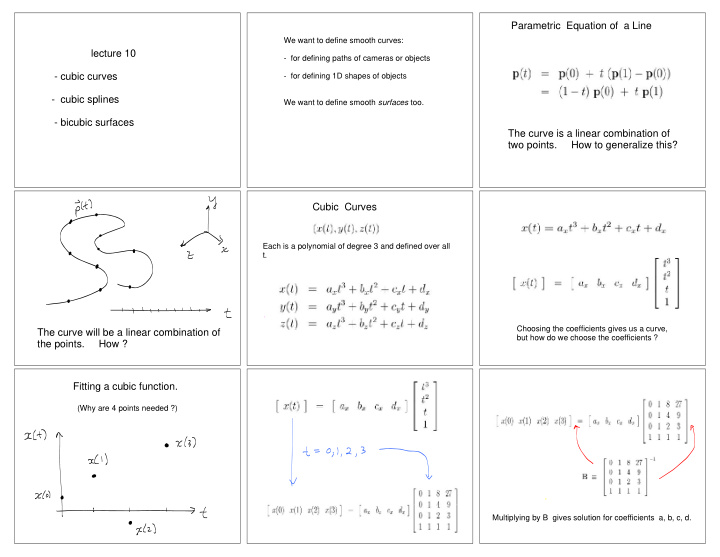



Parametric Equation of a Line We want to define smooth curves: lecture 10 - for defining paths of cameras or objects - cubic curves - for defining 1D shapes of objects - cubic splines We want to define smooth surfaces too. - bicubic surfaces The curve is a linear combination of two points. How to generalize this? Cubic Curves Each is a polynomial of degree 3 and defined over all t. Choosing the coefficients gives us a curve, The curve will be a linear combination of but how do we choose the coefficients ? the points. How ? Fitting a cubic function. (Why are 4 points needed ?) Multiplying by B gives solution for coefficients a, b, c, d.
We apply the same technique for y(t) and z(t) . I will walk through the derivation again, but this time solve for all x(t), y(t), z(t). Now what ? Trying to solve for this. geometry A blending matrix is 4 x 1. Each row is a polynomial of degree 3 in t. The blending matrix B is independent of the geometry matrix ! It can be precomputed once and blending stored. This gives us the 4x4 coefficient matrix (a,b,c,d). Suppose we are given n >> 4 points and we would like a We could take There is no reason why the resulting curve should be smooth curve through them in given order. How? smooth at the knots. [ p0, p1, p2, p3 ] [ p3, p4, p5, p6 ] [ p6, p7, p8, p9 ] and make cubic curve segments for each, and put them together at "knot" points. Q: Does that work ? A: No, we might have tangent discontinuities.
Splines Tangent Vector In mathematics, a spline is a piecewise polynomial In general, curves used for interpolating between points are function. called ’splines’. It should satisfy some continuity condition at the places (called "knots") where the polynomial pieces join. An example is that the "tangent" is continuous ... Hermite Curve Hermite Curve How to reformulate the problem to http://en.wikipedia.org/wiki/Charles_Hermite http://en.wikipedia.org/wiki/Charles_Hermite consider tangents? Given this: How can we use these data to choose matrices as follows ? Q: What are the weights at time t = 0, 1 ? A: Multiply both sides by the following. This gives us the coefficient matrix.
The tangents are equal at the knots (good). Bézier Curve Hermite Cubic Spline How do we fit a curve to n point + tangent pairs ? "Bernstein polynomials" for t in [0, 1], they lie in [0,1] and they sum to 1. (convexity property) Convexity property can be useful for clipping and intersections e.g. bounding volume. Catmull-Rom Spline (Motivation) lecture 10 Catmull-Rom Spline With Bezier, we avoided specifying tangent vectors but - cubic curves now the curve passes through only half the points. (Essentially, we are still specifying tangents.) - bicubic surfaces We would like to interpolate ALL points (unlike Bezier !) Exercise: what are the geometry and blending matrices? but also have the nice Hermite property of continuous tangent vector at knots.
Suppose we are given a 4x4 "grid" of 3D Start by fitting 4 cubic curves, corresponding to The solution is: points. s = 0, 1, 2, 3. Use the vanilla method at start of lecture. We would like to interpolate a surface. How ? Then, for each t, fit a cubic curve as a function of s. ... and similarly for y(s,t) and z(s,t). I will derive it over the next several slides. For each For any t, we have four points which we write as a row vector. This gives us our vanilla problem. s = 0, 1, 2, 3 Note: We’re only keeping track of x values here, but there are y and z values too. Stacking them gives: For any t, we fit a cubic of parameter s. Taking the transpose... Surface tangents and surface normals ... and replacing the right column with ... ... gives the answer.
surface tangents Summary surface tangents - cubic curve vs cubic spline - ’vanilla’, Hermite, Bézier, Catmull-Rom - geometry (control points) versus blending surface normal - defining tangents in terms of differences of point positions - lots of algebra that you should understand but not memorize Any linear combination of these is also a tangent.
Recommend
More recommend